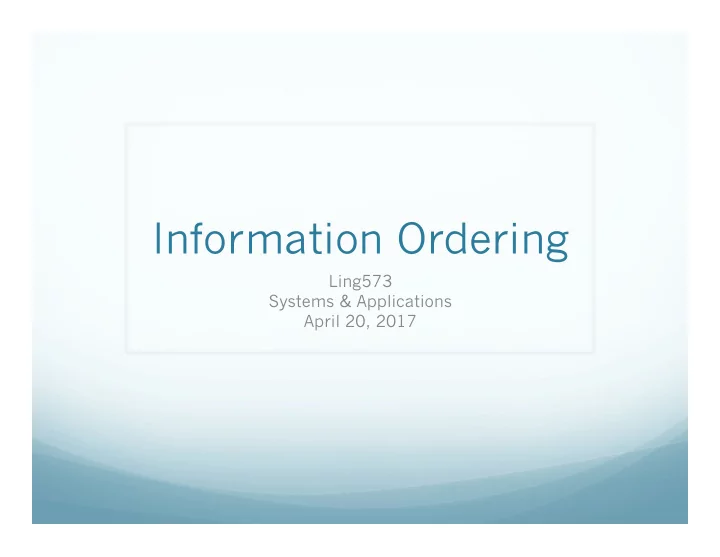

Information Ordering Ling573 Systems & Applications April 20, 2017
Roadmap Information Ordering: Basic approaches Variants on chronological ordering Ensembles for ordering
Basics Content selection: Identified sentences or information units for summary Information ordering: Linearize selected content into a smooth-flowing text Factors: Semantics Chronology: respect sequential flow of content (esp. events) Discourse Cohesion: Adjacent sentences talk about same thing Coherence: Adjacent sentences naturally related (PDTB)
Single vs Multi-Document Strategy for single-document summarization? Just keep original order Chronology? Ok Cohesion? Ok Coherence? Iffy Multi-document “Original order” can be problematic Chronology? Publication order vs document-internal order Differences in document ordering of information Cohesion? Probably poor Coherence? Probably poor
A Bad Example Hemingway, 69, died of natural causes in a Miami jail after being arrested for indecent exposure. A book he wrote about his father, “Papa: A Personal Memoir”, was published in 1976. He was picked up last Wednesday after walking naked in Miami. “He had a difficult life.” A transvestite who later had a sex-change operation, he suffered bouts of drinking, depression and drifting according to acquaintances. “It’s not easy to be the son of a great man,” Scott Donaldson, told Reuters.
A Basic Approach Publication chronology: Given a set of ranked extracted sentences Order by: Across articles By publication date Within articles
A Basic Approach Publication chronology: Given a set of ranked extracted sentences Order by: Across articles By publication date Within articles By original sentence ordering Clearly not ideal, but used in some eval. submissions
Improving Ordering Improve some set of chronology, cohesion, coherence Chronology, cohesion (Barzilay et al, ‘02) Key ideas: Summarization and chronology over “themes” Identifying cohesive blocks within articles Combining constraints for cohesion within time structure
Importance of Ordering Analyzed DUC summaries scoring poor on ordering Manually reordered existing sentences to improve Human judges scored both sets: Incomprehensible, Somewhat Comprehensible, Comp. Manually reorderings judged: As good or better than originals Argues that people are sensitive to ordering, ordering can improve assessment
Framework Build on their existing systems (Multigen) Motivated by issues of similarity and difference Managing redundancy and contradiction in docs Analysis groups sentences into “themes” Text units from diff’t docs with repeated information Roughly clusters of sentences with similar content Intersection of their information is summarized Ordering is done on this selected content
Chronological Orderings I Two basic strategies explored: CO: Need to assign dates to themes for ordering Theme sentences from multiple docs, lots of dup content Temporal relation extraction is hard, try simple sub. Doc publication date: what about duplicates? Theme date: earlier pub date for theme sentence Order themes by date If different themes have same date? Same article, so use article order Slightly more sophisticated than simplest model
Chronological Orderings II MO (Majority Ordering): Alternative approachto ordering themes Order the whole themes relative to each other i.e. Th1 precedes Th2 How? If all sentences in Th1 before all sentences in Th2? Easy: Th1 b/f Th2 If not? Majority rule Problematic b/c not guaranteed transitive Create an ordering by modified topological sort over graph Nodes are themes: Weight: sum of outgoing edges minus sum of incoming edges Edges E(x,y): precedence, weighted by # texts where sentences in x precede those in y
CO vs MO Neither of these is particularly good: Poor Fair Good MO 3 14 8 CO 10 8 7 MO works when presentation order consistent When inconsistent, produces own brand new order CO problematic on: Themes that aren’t tied to document order E.g. quotes about reactions to events Multiple topics not constrained by chronology
New Approach Experiments on sentence ordering by subjects Many possible orderings but far from random Blocks of sentences group together (cohere) Combine chronology with cohesion Order chronologically, but group similar themes Perform topic segmentation on original texts Themes “related” if, when two themes appear in same text, they frequently appear in same segment (threshold) Order over groups of themes by CO, Then order within groups by CO Significantly better!
Before and After
Deliverable #3 Goals: Focus on information ordering Using one or more of: Chronology, Cohesion, Coherence Continue to improve content selection Incorporate some guided/topic-orientation Same deliverable structure as D#2 Due in 3 weeks: Code/results; Updated report
Notes Deliverable 2: Code/results Updated project report Presentations next week: Doodle poll will be sent after class Please email me slide deck (or pointer) by noon If planning to present remotely, contact me to check audio
Recommend
More recommend